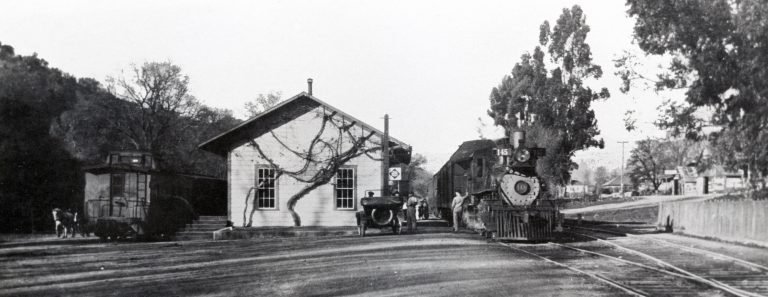
The Settlers
As homesteaders in the valley became farmers, the community began to grow, and the landscape of the Valley of the Moon began changing rapidly. The following links tell how.
Our Railroads
When the trains arrived in the Valley of the Moon in the 1880s, they thoroughly changed the world through which they traveled.
Charles Poppe
Charles A. Poppe established the first store in what was to become the business district of Glen Ellen.
Mary Ellen Pleasant
This strong abolitionist and feminist has long been misunderstood, but we are grateful for her presence in the Valley of the Moon.
Our Railroads
When the trains arrived in the Valley of the Moon in the 1880s, they thoroughly changed the world through which they traveled. People were able to reach greater distances much more quickly than ever before, and an industrial revolution was introduced to what was once a simpler and more casual world.
Glen Ellen has the distinction of being the only place in Sonoma County that had not one but two railroad stations. Even Sonoma, the big city down south, only had one. We like to think this was because, although the two railroads were in deep competition with one another, only the people of our little town were capable of bringing them together. It is however reported that there were occasional rock fights between crews, as their trains passed by one another.
Traces of the old railroads remain visible to this day, and can be found here and there— the paved paths of the regional park, the old rail car that had been resting until recently near the creek beyond the Village Market, the stationmaster’s house behind our post office, the foundation of the turntable up near the Gaige House— so many vestiges of a restless, vigorous time gone by.
Charles Poppe
Julius A. Poppe, married to Katherine Bohr Poppe, was a local rancher from 1851 to 1864; he then opened a general merchandise store in Sonoma, which he operated until his death in 1879.
His son Charles A. Poppe was born November 21st, 1853. Charles managed the family store in Sonoma until 1883, when he married Caroline H. Martens, and they opened their own store selling “Dry Goods, Groceries and General Merchandise”, establishing what was to become the business district in Glen Ellen.
The Glen Ellen Post Office was moved into his building, and Poppe served as postmaster for many years, from 1890 to 1916. In 1884 he served as clerk of the school board, and in 1888 he was secretary of the Native Sons of the Golden West. Poppe also served as clerk and treasurer of the First Congregational Church, which was built in 1894.
An unidentified newspaper clipping tells that on the evening of February 2nd, 1888, there was a meeting of the “Bald Headed Club” in Glen Ellen, and it “had quite a number attending— John Peters, T. J. Sullivan, Chas. J. Poppe, J. Chauvet, Bot Miller. Ayer’s Hair Vigor was decided as the most suitable restorative.”
The wooden store burned to the ground July 4th, 1905, and was quickly replaced by a two story stone building. Then, in the following year, the new stone building was severely damaged by the great earthquake on April 18th. The upper floor was then replaced by wooden 2nd and 3rd floors. At some time later the third floor was removed.
Mary Ellen Pleasant
Almost a century before Rosa Parks forced public acknowledgement of segregation on a bus in Montgomery, Alabama, Mary Ellen Pleasant sued and won the right for African-Americans to ride the trolleys of San Francisco in 1868. This strong-minded woman, who established Beltane Ranch in the Valley of the Moon, is an important but often misunderstood figure on American History.
She was derisively called “Mammy” Pleasant, and thought by many to be the proprietor of houses of ill repute. In fact, she was a staunch abolitionist and feminist who actively protected runaway slaves and abused women. The houses of ill repute she was thought to have managed were in fact safe houses, modeled after the underground railway she took part in after she herself was freed from slavery.



